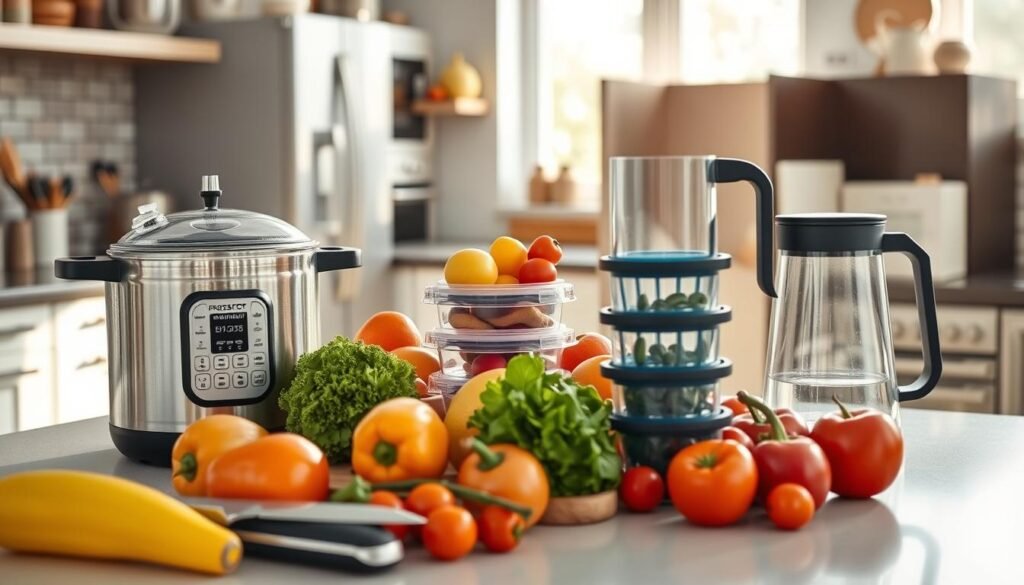Ever wonder if a simple pantry night or a 10-minute expense check could change your household finances?
I ask because, as a mom who times days by school drop-offs and dinner preps, I learned one thing: small kitchen-first habits add up fast.
Start with tracking: pull your bank and credit statements and record every expense by category. This mise en place makes it easy to spot leaks in spending and plan next steps.
Treat savings like a monthly bill. Move a set amount to a savings account right after payday, or split your direct deposit. Automating transfers is my favorite trick when hands are full.
Set short-term goals (a $500 starter fund) and long-term goals (home or retirement). Try a no-spend month or a 52-week challenge to build momentum without stress.
Key Takeaways
- Record every expense using bank and credit statements to see where money flows.
- Treat savings as a monthly bill and automate transfers to an account.
- Set clear short- and long-term goals to guide your budget and spending.
- Use kitchen-first tactics—pantry nights and simple weekly menus—to cut costs easily.
- Try one-month challenges to build savings habits and reduce debt pressure.
Fast starts: Five-minute habits that cut kitchen costs today
Five minutes a day in the kitchen can trim weeks of waste and impulse buys. Small rituals pause impulse spending and build steady savings without drama.
- Pick one no-spend kitchen day for leftovers and pantry finds. That habit helps you save money while using what you already have.
- Use a 24-hour rule before nonessential purchases—add the gadget to your cart, wait a day, then decide.
- Do a five-minute fridge sweep before dinner. The “use me first” bin saves time, reduces waste, and nudges savings.
Gamify it: Weather Wednesday transfers or a 52-week challenge turn small wins into bigger savings. Library night replaces dessert runs and keeps kids happy.
| Quick Action | Time | Benefit |
|---|---|---|
| No-spend kitchen day | 1 day/week | Use pantry, reduce store trips |
| 24-hour rule | 1 day | Fewer impulse purchases |
| Five-minute sweep | 5 minutes | Less waste, quick meal ideas |
| Envelope for snacks | 7 days | Limits spending, teaches kids |
Tiny habits stack: every no-spend day I tap transfer and move the saved cash to my bank app. That simple push helps me start saving while life stays busy.
Budget basics for busy weeks: Build a plan that sticks
On hectic weeks I treat budgeting like a simple recipe: pull the ingredients, follow the steps, and taste as you go.
Track every expense by pulling bank and credit card statements for 15 minutes each pay cycle. Categorize purchases—groceries, gas, utilities, mortgage—and add a savings line. Seeing it all stops mystery leaks and makes the next step obvious.
Make savings a monthly expense
Treat savings like rent: automate a portion of each paycheck so you consistently build up to 10–20% of income. I split direct deposit and move funds the morning after payday. That habit helps you start saving money without thinking about it.
Automate and review
Add sinking funds for irregular costs (car maintenance, school fees) so one-off bills don’t blow up your month. Scan fixed bills—auto and home insurance—and compare rates yearly. If card interest is high, prioritize paying that debt while keeping a small cushion.
- I block 15 minutes to pull statements and note grocery and gas averages.
- One-page budget + weekly check-in keeps the plan working (coffee and pasta boil time check!).
| Category | Action |
|---|---|
| Groceries/Gas | Track 3-month average |
| Savings | Automate 10–20% of income |
| Fixed bills | Review insurance and rates yearly |
Meal planning that actually works when you work
Predictable meals are the kitchen’s autopilot. When work or activities pile up, a simple plan keeps evenings calm and keeps your goals on track.
Plan simple rotations: choose 3–4 breakfasts, packable lunches, and three easy dinners each week. This small rhythm saves time and trims impulse buys at the store.
- Double favorite recipes—chili, baked ziti—and freeze half for a future no-cook night.
- Batch-cook bases (rice, roasted veggies, shredded chicken) and remix them all week.
- Keep a “15-minute meals” column for the nights work runs late—quesadillas, omelets, naan pizzas.
“Shopping from a menu-made list helped me cut aisle temptations and added real savings to our budget.”
Create a smart list from your weekly menu so you buy only what you need. Set a small goal: one extra home-packed lunch per week. That one switch is an easy way to build steady savings while keeping your home life smoother.
Grocery store strategies to outsmart marketing and inflation
Grocery aisles are full of tricks, but a simple plan helps you walk out with what you need—and nothing you don’t. I use a short menu-based list and a quick snack before I go. That small ritual is a proven way save money each year.

Shop with a list and eat first
Never shop hungry. A snack shrinks impulse purchases and curbs spending. Make your list from the week’s menu and stick to it. Sticking to a plan can protect your savings and cut dozens of tiny regrets at checkout.
Leverage store brands and coupons for staples
- Compare unit prices; pick store brands for staples.
- Clip coupons only for items you already buy—chasing deals can lead to a bad purchase.
- Jot three low-cost swaps (cabbage, dried beans, drumsticks) and repeat them each month.
Use apps and loyalty rewards—wisely
Use loyalty cards to drop totals at checkout, but stop after the benefit. If you pay with a credit card, have the funds set aside and clear the balance this month. Or use cash for treats to keep the plan honest.
| Tactic | Action | Benefit |
|---|---|---|
| List + snack | Shop after a quick bite | Fewer impulse buys |
| Store brands | Compare unit price | Lower grocery bill |
| Loyalty card | Use discounts, avoid extra trips | Real savings at checkout |
Pantry power: Stock once, save all month
A little prep up front turns scattered food into a month’s worth of simple meals. I treat the pantry like a short recipe list—grab staples, mix, and dinner is done.
Build a core pantry
Keep essentials—rice, beans, pasta, canned tomatoes, and frozen veggies—so dinner is 20 minutes away and you avoid last-minute runs. Batch-cook beans and freeze in 1.5-cup portions (can-sized) to save time.
Try a pantry challenge
Adopt a 7-day pantry challenge: plan every meal from what you already have and bank the funds you didn’t spend. Doubling recipes and freezing halves another day’s work and protects your savings.
- List ten pantry MVP meals (taco bowls, bean soup, pasta puttanesca) for busy nights.
- Rotate stock: oldest in front, newest in back to cut waste.
- Keep a “use me next” note on the fridge to guide quick choices.
- Repurpose leftovers (roast veg → frittata; chicken → noodle soup) so nothing goes stale.
- When prices jump, stretch proteins with grains and veggies for fuller plates.
“One pantry dinner a week became a tiny goal that added up to real savings.”
Small wins matter: these ideas form one reliable way to reach your goals while freeing up time and easing the month. Try one pantry night this week and track how it helps your household.
Appliances, utilities, and home tweaks that lower kitchen bills
Think of the kitchen as a small utility plant—tiny tweaks here change the household bill. Small changes to how you cook and seal the house add up fast. Ask your utility for a free or low-cost energy audit. That quick check often shows easy weekend fixes.
Audit energy use: LEDs, filters, and efficient cooking
Switch to LED bulbs and change HVAC and range hood filters regularly. Clean filters let systems run less and last longer.
Cook smarter: pressure cookers, microwaves, and batch-baking use less energy and less time than long oven sessions. Match pot size to the burner and use lids—small moves that make a real difference.
Weatherproofing, thermostat and water heater tips
Caulk and weather-strip doors and windows to cut heating and cooling loss. Lower your water heater to 120°F; each 10° down can trim roughly 5% from the bill.
- I treat the kitchen like a mini power plant—LED bulbs, clean range hood and HVAC filters make a noticeable difference on bills.
- Ask for a utility energy audit; even a basic checklist can uncover easy savings you can do in a weekend.
- If allowed in your state, compare electricity or gas provider rates or call as a long-time, on-time customer to negotiate.
- Put big draws (dishwasher, laundry) on off-peak if your plan supports it and check your local rates.
- Review home insurance bundles and cell phone plan timing with utility changes; bundling can lower overall insurance costs.
“These simple tweaks freed up cash I could send to savings or chip at a stubborn debt.”
Small habits add up: use lids, avoid needless preheating, and batch tasks. Over a month, the difference shows on the statement—and in the time you get back for family life.
Smart payments in the kitchen economy: Rewards, cash, and timing
Timing your payments is a quiet kitchen trick that keeps small purchases from growing into big bills.
Use rewards only when you avoid interest. A credit card can earn perks, but interest erases that value fast. Pay the full statement balance each month to actually benefit.
Pay in full and automate
I set an auto-transfer to our savings account the morning after payday. That way, we build savings before we spend.
Match treats with a tiny ritual
Buy a treat? Put the same amount into savings or stash equivalent cash. This turns fun into forward progress toward our goals.
“Rewards matter only when the balance is cleared—interest is the thief you don’t see.”
- make sure autopay uses the statement balance, not the minimum due.
- Keep one primary account for bills and one for daily spending to avoid overdrafts.
- Cap eating-out or snacks per week; when the envelope is empty, the spending stops.
| Tactic | Action | Benefit |
|---|---|---|
| Pay statement in full | Set autopay to statement balance | Avoids interest charges |
| Auto-transfer | Split direct deposit to savings account | Builds consistent savings |
| Match indulgence | Move equal cash to savings | Turns treats into progress toward goals |
Ways save money beyond the fridge: Debt, insurance, and subscriptions
When the fridge is full, the next wins often come from tackling bills and subscriptions. Small, steady moves outside the kitchen can free up cash for groceries and goals. Treat this as a simple weekly check-in.

Reduce credit balances to free monthly cash
High-interest debt drains your budget fast. Pick a plan you can live with—snowball for quick wins or avalanche to attack the highest rates first.
Tip: Make a mid-cycle extra payment on a credit card to cut average daily balance and interest.
Review auto and home insurance each year
Call your insurer before renewal and compare premiums. Many families overpay because they never check rates or ask about bundle and safe-driver discounts.
Also check your bank accounts and credit reports yearly; fixing errors can boost your score and lower loan costs.
Audit subscriptions and small leaks
Cancel unused meal kits and streaming services. If you didn’t use it this month, unsubscribe and move that amount to savings.
Put essentials on auto-pay to avoid late fees, and stick to your bank’s ATMs to dodge extra charges.
| Action | How | Benefit |
|---|---|---|
| Debt plan | Snowball or avalanche | Lower interest, more monthly cash |
| Insurance review | Compare rates annually, ask for discounts | Better premiums, fewer surprises |
| Subscription audit | Cancel unused services, redirect funds | More savings for groceries and goals |
| Credit check | Review report yearly | Fix errors, improve credit |
“Tiny trims outside the kitchen free up cash for groceries, goals, and calm.”
Save money goals for your family’s future
Think of goals like recipes: pick amounts, set dates, and follow a simple method that fits your life. I write goals in clear steps so they feel doable and not overwhelming. 😊
Set short-term and long-term targets with dates
Short-term: $500 starter emergency fund in 3 months. Later, build 3–9 months of living expenses.
Long-term: home down payment, college, and retirement with target years and amounts. Park short-term funds in a separate savings account so they stay untouched.
Use employer benefits and paycheck splits
Contribute enough to get the full 401(k) match—that free employer match is an instant win. Fund an HSA for health costs if eligible and use FSA for child care pre-tax. Split direct deposit so part of each paycheck moves to savings before life spends it.
Dedicate windfalls and automate progress
Decide ahead what to do with tax refunds or bonuses: X% to savings, Y% to debt, Z% for small joys. Increase contributions after a raise by 1–2% to keep momentum.
| Goal | Amount | When |
|---|---|---|
| Starter fund | $500 | 3 months |
| Emergency cushion | 3–9 months expenses | 12–36 months |
| Retirement/college | Custom target | 5–30 years |
“Small, steady steps protect your family’s future.”
Conclusion
Wrap this up with a simple promise: pick one practical change and keep it for a month. ,
Try a pantry night or a 24-hour pause before nonessential buys. One steady habit is the easiest way save money while life stays busy.
Review your budget once a month, automate a small transfer the day after each paycheck, and boost your 401(k) when you get a raise. Pay credit cards in full to avoid interest and compare insurance and utility rates yearly (LEDs and a 120°F water heater help, too).
Small, repeatable steps—no-spend days, tiny transfers to an account, or one home tweak—make a real difference. You’ve got this, mama; one small change a day builds lasting savings and a kinder plan for your home and work life.


